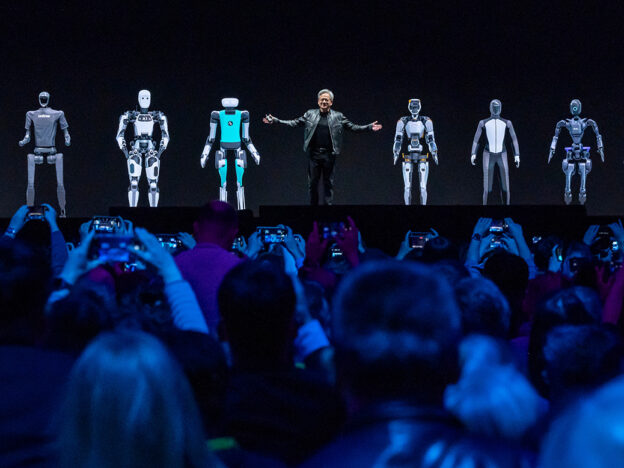Nvidia (NVDA) continues to ride the AI wave as cloud giants Amazon (AMZN), Google (GOOG, GOOGL), Meta (META), and Microsoft (MSFT) snatch up as many of its data center chips as they can.
And while shares of the chip company are off 10% year to date, they’re still up 27% over the past 12 months and more than 700% since 2023. Revenue is also soaring, jumping from $27 billion during the company’s fiscal 2023 to $130 billion in fiscal 2025.
But during Nvidia’s GTC event last week, CEO Jensen Huang repeatedly made the case for the company’s next major AI innovation: robotics. Huang is looking to use Nvidia’s digital AI prowess to grow what he calls physical AI, including self-driving cars and humanoid robots.
“We are … world class with robotic safety. I believe this expertise is going to pay off big someday,” the CEO said during a press briefing during the conference.
“We’ve been investing in this area for 10 years now. It’s a multibillion-dollar business for us already … and I think this is going to be one of the largest businesses for the company long term,” Huang added.
Read more: How does Nvidia make money?
Nvidia’s physical AI push
A quick tour of Nvidia’s GTC showcase at the San Jose McEnery Convention Center offered a glimpse at Nvidia’s robotics ambitions, with exhibits ranging from robotic arms to human-size bipedal robots.
On one side of the large hall, the company displayed its own prototype of a robotic ultrasound machine as an example of how businesses can take advantage of its technologies.
The voice-activated bot included a single mechanical arm with a camera and scanner. When I told it to perform a liver scan, it quickly located the organ on a dummy torso and performed the procedure. A display mounted behind the setup showed the live results, which I can only assume is what a liver looks like on an ultrasound.
I’m a reporter, not a doctor.
In the next stall, Agility Robotics showed off its Digit robot as it grabbed items off a faux store shelf and put them into a shopping basket, completing the task over and over again like some kind of Sisyphean nightmare. A litany of other robotic arms and a Boston Dynamics Spot were also on display at the event.
A 3-in-1 deal
Huang is banking on robot makers relying on a three-computer system that Nvidia has developed to train and run the machines.
The first system includes Nvidia’s DGX AI systems, which customers use to develop AI robot models. Then there’s the Nvidia Omniverse system, which customers use to train their robotic models to navigate the real world in a virtual setting.
The idea is to ensure customers can subject their robots’ AI models to a litany of potential scenarios ranging from falling down stairs to crashing into walls to trying to avoid falling air conditioners without having to put them — or the people around them — in any real-world danger.
“You want to simulate … millions of miles of [a car] driving, test it out beforehand, and then deploy it,” Nvidia vice presidence of Omniverse and simulation technology Rev Lebaredian told Yahoo Finance.
“And [it’s] the same for all robots. I’m using cars as an example, but the robots we have in our factories. These are multimillion-dollar factories. Any amount of downtime costs millions of dollars and opportunity cost, or they can be dangerous too. You don’t want them hurting the robots themselves or hurting people that are also in those factories.”
The final component is Nvidia’s Jetson Thor onboard computer, which runs those trained AI models. Think of it as something of a robotic brain. Vehicles would use Nvidia’s AGX Thor.
Nvidia faces stiff competition and headwinds
Nvidia isn’t the only company looking to capitalize on the promise of a robot-filled future. Amazon, Apple, Google, Meta, Microsoft, and Tesla are each working on some element of the robot ecosystem.
Then there are the practical hurdles companies must overcome before robots become a part of our everyday lives. Humanoid robots are still incredibly expensive — upwards of tens of thousands of dollars — and their batteries still don’t last very long before needing a top-off.
And while self-driving cars continue to expand to more cities, we’re still some time from the day when you can hop into your car’s driver’s seat and take a nap on the way to the office.
Nvidia, however, has a history of continuing to develop technologies it believes in until they break into the market. Look no further than its graphics card software and AI capabilities. And if Nvidia can do the same with robotics, it could be a whole new opportunity for the chip giant.
https://finance.yahoo.com/news/nvidia-sees-robots-as-its-next-big-market-opportunity-192843855.html





